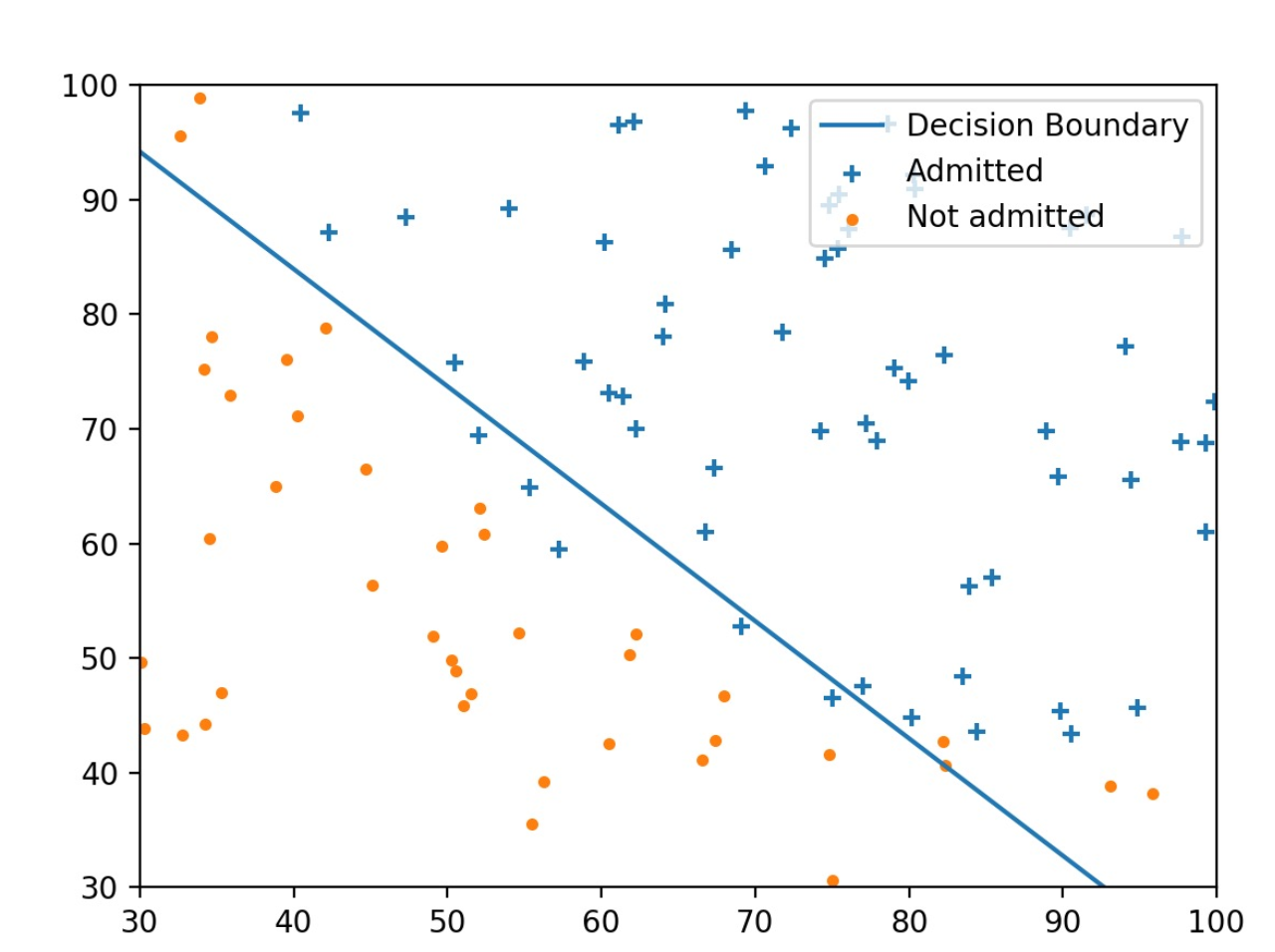逻辑回归解决的便是一个分类的问题。就是需要一段代码回答YES或者NO。 比如辣鸡邮件的分类,当一封邮件过来,需要识别这封邮件是否是垃圾邮件。
一个简单的例子
笔者借用Andrew Ng给的学生成绩与申请大学的例子来讲述Logistic Regression算法实现。假设你有学生的两门课的历史成绩与是否被录取的记录,需要你预测一批新的学生是否会被大学录取。其中部分数据如下:
| exam1 | exam2 | 录取(0:failed; 1: passed) |
|---|---|---|
| 34.62365962451697 | 78.0246928153624 | 0 |
| 30.28671076822607 | 43.89499752400101 | 0 |
| 35.84740876993872 | 72.90219802708364 | 0 |
| 60.18259938620976 | 86.30855209546826 | 1 |
| 79.0327360507101 | 75.3443764369103 | 1 |
| 45.08327747668339 | 56.3163717815305 | 0 |
| 61.10666453684766 | 96.51142588489624 | 1 |
这里exam1和exam2的分数作为模型的输入,即X。 是否被录取则是模型的输出, 即Y, 其中
假设函数
我们定义个假设函数 , 通过这个函数来预测是否会被录取的概率。所以我们希望
的取值范围是[0, 1]。
sigmoid函数是一个匹配度很高的函数。如下是sigmoid函数的图像:

我们利用python来实现这个函数:
import numpy as np
def sigmoid(z):
g = np.zeros(z.size)
g = 1 / (1 + np.exp(-z))
return g
我们假设的定义为:
我们可以令的定义为:
代价函数)
给出了的定义以后,我们就可以定义
了
为了在进行梯度下降时找到全局的最优解,的函数必须是一个凸函数。所以我们可以对
Cost进行如下定义:
最后求出梯度下降算法所需要使用的微分即可:
利用python的实现如下:
import numpy as np
from sigmoid import *
def cost_function(theta, X, y):
m = y.size
cost = 0
grad = np.zeros(theta.shape)
item1 = -y * np.log(sigmoid(X.dot(theta)))
item2 = (1 - y) * np.log(1 - sigmoid(X.dot(theta)))
cost = (1 / m) * np.sum(item1 - item2)
grad = (1 / m) * ((sigmoid(X.dot(theta)) - y).dot(X))
return cost, grad
我们使用scipy来对该算法的求解做一定程度的优化:
import scipy.optimize as opt
def cost_func(t):
return cost_function(t, X, y)[0]
def grad_func(t):
return cost_function(t, X, y)[1]
theta, cost, *unused = opt.fmin_bfgs(f=cost_func, fprime=grad_func,
x0=initial_theta, maxiter=400, full_output=True, disp=False)
通过这个方法,可以求出在模型中所需要使用的。从而将该模型训练好。
可视化
为了方便观察数据之间的规律,我们可以将数据进行可视化出来
def plot_data(X, y):
x1 = X[y == 1]
x2 = X[y == 0]
plt.scatter(x1[:, 0], x1[:, 1], marker='+', label='admitted')
plt.scatter(x2[:, 0], x2[:, 1], marker='.', label='Not admitted')
plt.legend()
def plot_decision_boundary(theta, X, y):
plot_data(X[:, 1:3], y)
# Only need two points to define a line, so choose two endpoints
plot_x = np.array([np.min(X[:, 1]) - 2, np.max(X[:, 1]) + 2])
# Calculate the decision boundary line
plot_y = (-1/theta[2]) * (theta[1]*plot_x + theta[0])
plt.plot(plot_x, plot_y)
plt.legend(['Decision Boundary', 'Admitted', 'Not admitted'], loc=1)
plt.axis([30, 100, 30, 100])
plt.show()
效果是这样的:

预测
当求出了之后我们当然可以利用这个来进行预测了,于是可以编写
predict函数
import numpy as np
from sigmoid import *
def predict(theta, X):
m = X.shape[0]
p = np.zeros(m)
prob = sigmoid(X.dot(theta))
p = prob > 0.5
return p
对于X中的数据,当概率大于0.5时,我们预测为能通过大学申请。
以上便是逻辑回归算法的基本实现,逻辑回归在ML中是一个很基本也很强大的算法,希望这篇文章对你有所帮助
